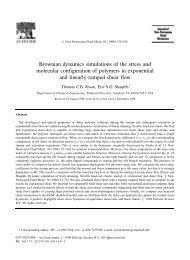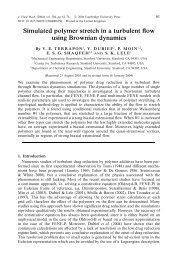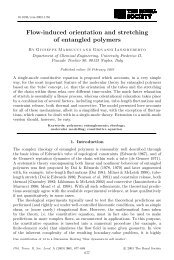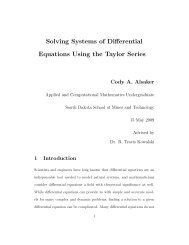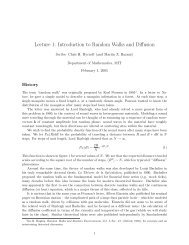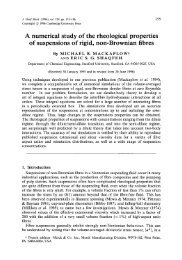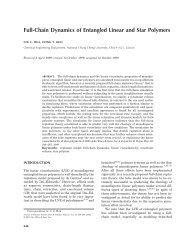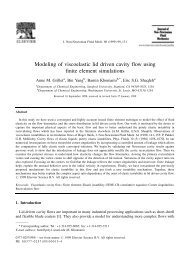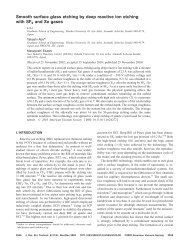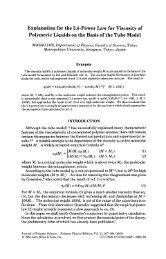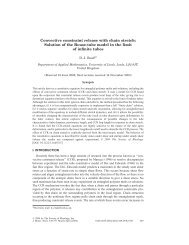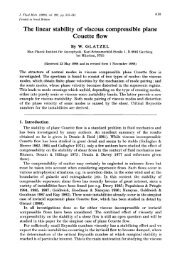Molecular modelling of entangled polymer fluids under flow The ...
Molecular modelling of entangled polymer fluids under flow The ...
Molecular modelling of entangled polymer fluids under flow The ...
You also want an ePaper? Increase the reach of your titles
YUMPU automatically turns print PDFs into web optimized ePapers that Google loves.
Chapter 1<br />
Introduction<br />
1.1 Overview<br />
Rheology is the study <strong>of</strong> the deformation <strong>of</strong> matter. In particular, it is the term<br />
used to describe the study <strong>of</strong> complex <strong>fluids</strong> such as <strong>polymer</strong> melts, <strong>polymer</strong> solutions<br />
and colloidal suspensions. <strong>The</strong> aim <strong>of</strong> theoretical rheology is to develop constitutive<br />
equations that relate stress within the material to its deformation history. Constitutive<br />
equations together with mass and momentum conservation can be used to predict<br />
the <strong>flow</strong> <strong>of</strong> the material. <strong>Molecular</strong> rheology aims to derive and <strong>under</strong>stand these<br />
constitutive equations from the <strong>under</strong>lying microscopic physics <strong>of</strong> the material.<br />
Polymer are large macromolecules. <strong>The</strong>y consist <strong>of</strong> many chemical repeat units<br />
covalently bonded into long chains. Chain with N = 10 2 − 10 4 repeat units can be<br />
synthesised and <strong>polymer</strong> <strong>of</strong> length N = 10 9 −10 10 occur in nature. <strong>The</strong> topology <strong>of</strong> the<br />
chain can vary from a simple linear chain to a complex branched structure. Chemically<br />
identical materials with the same molecular weight but different topologies <strong>of</strong>ten have<br />
radically different rheology. Conversely materials with different chemistries but with<br />
molecules <strong>of</strong> globally the same shape <strong>of</strong>ten exhibit evidence <strong>of</strong> universal behaviour.<br />
<strong>Molecular</strong> rheology <strong>of</strong> <strong>polymer</strong>s has a long history [Bird et al. (1977), Larson (1988),<br />
de Gennes (1979)]. However, work in this area has intensified in the last twenty years.<br />
Understanding <strong>polymer</strong> rheology is important not only from the point <strong>of</strong> view <strong>of</strong> fundamental<br />
science but because its applications <strong>of</strong>ten have very useful industrial consequences.<br />
A good <strong>under</strong>standing <strong>of</strong> the link between the molecular constituents <strong>of</strong> a<br />
<strong>polymer</strong> liquid and its rheological behaviour is a long term goal <strong>of</strong> molecular rheology.<br />
This would allow the production <strong>of</strong> materials with a rheology that is tailored to their<br />
application.<br />
<strong>The</strong>re are many processing problems which are thought to be avoidable if a material<br />
has the correct rheology. For example, in a film blowing process small areas <strong>of</strong> thinning<br />
in the film may grow in amplitude leading to rupture <strong>of</strong> the film. By changing the<br />
1



